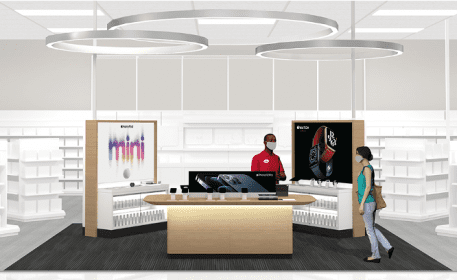Target Leads ‘Store Within A Store’ Trend As Retailers Show New Love For Old Tactic
When Target announced it was “extending and expanding” its relationship with Apple last month, it was not just about carving out more space to sell more iPhone and iPads, it was about aligning with a winning brand that customers love but more so about boosting traffic that will lead shoppers to buy other things while they’re in the store.
The so-called “store within a store” concept is by no means a new idea, but it is one that is experiencing a bit of a post-COVID renaissance, at a time when digital sales and conveniences like curbside pickup have taken a bite out of traffic.

Image courtesy of Target
“Apple products are popular with Target’s guests,” said Christina Hennington, executive vice president and chief growth officer at Target, adding that the elevated in-store Apple experience is also designed to enhance Target’s reputation as a go-to destination for electronics.
With plans to roll out an initial 17 revamped Apple stores, and more expected to open up in the fall, the Minnesota-based retailer is clearly analyzing the cost-to-benefit metrics of deepening its ties to Apple. Target has already been doing business with Apple for 15 years.
“This new model was created with Target’s guests in mind, and we’ll continue to learn and enhance the experience through future rollouts later this year,” Hennington added.
Not Just Target
The store-within-a-store concept has long been a staple of the cosmetics industry, but has seen recent enlargement via a 200 stores deal between Kohl’s and Sephora, as well as an initial 100 mini-store deal announced in November between Target and Ulta Beauty.
Target is also in the throes of a 100-SKU in-store and online promotion with Levi’s that goes well beyond jeans and into kitchen, pets and range of denim-inspired accessories.
Not to be outdone, luxury retailer Nordstrom announced earlier this month that it was adding 40 mini-Tonal stores averaging 50 square feet within its properties that will place the $3,000 digital workout systems alongside sportswear and sneakers.
“Our goal is to help customers discover the latest active gear for style, performance and everything in-between, and we look forward to making it easier than ever to discover everything in one place so they can look and feel their best,” said Nordstrom Vice President and Divisional Merchandise Manager Lori Marten.
Coffee shops like Dunkin Donuts and Starbucks have thousands of store-in-store locations in everything from gas stations to grocery stores, as does the post-bankruptcy remains of Radio Shack.
Even Midwestern supermarket chain Hy-Vee is in on the trend, having just announced plans that it will be opening nail salons at select locations across an 8-state region starting next month.
“We are revolutionizing the way customers shop in our stores by bringing engaging, experiential and convenient services to our customers,” said Hy-Vee CEO Randy Edeker, who also unveiled the grocer’s first shop-in-shop location with shoe retailer DSW in September.
“Designer Brands [the parent of DSW] continues to innovate the retailing experience and we remain committed to bring our customers differentiated experiences and address their evolving shopping habits,” said Designer Brands Chief Growth Officer Bill Jordan.
Location, Location, Location
Whether it’s tech, toys, T-shirts or toilet paper, one of the first and most important axioms of retailing is the need to get people into the store before you can start selling to them. But once shoppers are “in the house” the magic of merchandising takes over and the ability to tempt shoppers with low-priced impulse buys near checkouts and major aisles and alert them to the availability to deliver forgotten household staples, is a time-tested way to increase basket size, or the amount of stuff people buy per visit.
As much as “location, location, location” is an equally well-traveled industry adage, the need to get feet on the ground is arguably even more important today than ever since as much as 20 percent of total retail sales are being done online where prime real estate is less important than seamless transactions and data security.
For Macy’s, which now calls itself a digitally-led omnichannel retailer rather than a department store, the micro-store concept is working, and therefore, also going to be expanded.
“Backstage [Macy’s off-price retail chain] will continue to be a significant element of our assortment strategy. Last year, Backstage outperformed comp sales in Macy’s stores by more than three times,” CEO Jeff Gennette said on the company’s earnings call last month, “and we plan to open about 35 new store-within-stores in 2021.”
